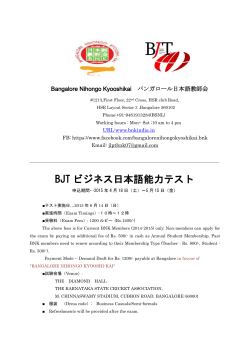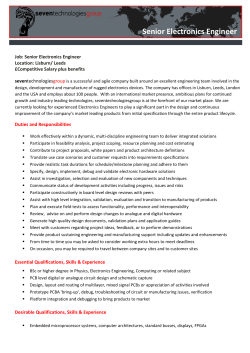
08-1 BJT Models - brd4.braude.ac.il
Theory of Analog Electronics
BJT
Part 1. BJT Models
* In this presentation definitions and examples
from Wikipedia, HowStaffWorks and some other sources
were used
ORT Braude Engineering College. Course: Theory of Analog Electronics 31401.
Lecturer: Dr. Samuel Kosolapov ksamuel@braude.ac.il
Quiz 08. 1 (before the start):
Do You need this lecture ?
2
Items to be
defined/refreshed/discussed
• BJT appearance
• Ebers-Moll Model
• BJT Characteristics
3
BJT
BJT – Bipolar Junction Transistor
Transistor – TRANsformer of reSISTance
P-N-P BJT Transistor
N-P-N BJT Transistor
4
BJT: 4 Operation Modes
Operating Modes in the BJT (2 Junctions 4 combinations are possible)
Mode
Forward-active
Cutoff
Saturation
Reverse-active
Emitter-Base
Junction State
Forward biased
(open)
R
F
R
Collector-Base
Junction State
Reverse biased
(closed)
R
F
F
For Analog Electronics: only Forward-Active Mode (Region) is relevant
Other modes are used in Digital Electronics
5
BJT: Modes for Digital Electronics
Cut-Off state: (VCE>0, VBE<0.7V all currents are very small)
Both diodes are Reverse-Biased ; transistor equivalent is “OPEN SWITCH”:
Saturation State: (Left non-linear part of IC - F(VCE, IB) curves. IB > ICsat/HFE )
Both diodes are Reverse-Biased; transistor equivalent is “CLOSED SWITCH”:
More info (and info about Reverse-Active mode) sees in Digital Electronics books
(Mauro, and Millman course). Used in 74** TTL gates.
6
BJT: Idea Device Nobel Prize Hard Work
Non-Linear Model (DC & AC) Linear Small-signal AC model
Ebers-Moll Model of BJT NPN Transistor
(By P.Lynch. Worked Examples in Physical Electronics, 1972 (absent in ORT Library)
See also Millman-Hakias. Integrated Electronics, pp. 147-148
Millman-Grabel. Microelectronics. 621.381 MIL pp. 87-89
7
BJT: Ebers-Moll Model
8
BJT: Ebers-Moll Model Input Characteristics
IB=F1( VBE, VCE )
~ Simple Diode.
Nearly no influence of Vce:
(0.3V and 10 V)
9
BJT: Ebers-Moll Model Input Characteristics
IB=F1( VBE, VCE ) in 3D
Taylor Approximation will be
good here !!!
Attention:
For Vce < ~0.2 V
more complex graph
10
BJT: Ebers-Moll Model Output Characteristics
IC=F2( Vce, IB ) {MAPLE: Symbolic formula is ~ 6 pages}
11
BJT: Ebers-Moll Model Output Characteristics
IC=F2( Vce, IB ) in 3D
12
BJT: Ebers-Moll Model H-Parameters
Feedback: ~ 0
Good
H12=HFE = b ~ 100:
Current Gain
H22=HOE :
Exaggeration
H11=HIE = 1kW:
13
BJT: Ebers-Moll Model Large Signal Model #1
14
BJT: Ebers-Moll Model Large Signal Model #2
15
BJT: Ebers-Moll Model Large Signal Model #3
Rebf
16
BJT: Example: Common Base Amplifier
Results of Simulation:
Mode test:
Inspecting E-B-C Voltages:
VEB < 0 VBE>0 BE diode is Forward-Biased
VCB > 0 CB diode is Reverse-Biased
Forward-Active Mode
Voltage Gain: (10.06-10.55) /( (-2.8) – (-2.7 ) = +4.9
17
BJT: Example: Common Base Amplifier
Manual Solution with simplest model
No sub-division for DC and AC !!!!!
SUPPOSE (and this MUST be CHECKED at the end,
(otherwise we CAN NOT use this model),
that transistor is in Forward-Active state.
First step: REPLACE transistor to its model (Model 2 here):
18
BJT: Example: Common Base Amplifier
Manual Solution with simplest model
Calculate Voltages and Currents
IE
V
signal
V0
Rsignal
F
VC F I E RC VCC ;
b
;
1 F
F Vsignal V0 RC
b RC
Vsignal V0 VCC
VC
VCC
Rsignal
b 1 Rsignal
1
VC
RC
1
F I E VCC
RC
19
BJT: Example: Common Base Amplifier
Manual Solution with simplest model
Get Numerical Results
b = 100 – parameter of the transistor.
VC1 = (100/(1+100))*(5/1)*(2.7-0.7)= 9.900990100 V
VC2 = (100/(1+100))*(5/1)*(2.8-0.7) = 10.39603961 V
“Voltage Gain” = 4.96
DC Test: For Vsignal used, VBE >0 ( VEB<0) , VBC<0 (VCB>0) Forward-Active Region,
By the way, Vc ~ Vcc/2
RESULT: DC state wasestimated. Voltage/Current Gain was estimated.
20
BJT: More Models
More BJT Models:
Reminder:
Original Ebers-Moll Model:
Active Region:
Dbe if Forward Biased (open)
Battery 0.7 V + resistor
Dbc is Reverse Biased (closed)
No connection Icr = 0
Ar*Icr = 0
Ebers-Moll for Active Region is
21
BJT: Model and Relevant Equations
I C F I E ; I E I B I C I B F I E ;
IB
F IB
IE
; I C F I E
; I C H FE I B ;
1F
1F
F
H FE {b }
; {H FE H 21 } {FE : Forward Emitter}
1F
Example : F 0.99 H FE 99 ~ 100
I E I B I C I B H FE I B 1 H FE I B
22
BJT: Alternative Drawing
I EF I E ;
F IB
F I EF F I E I C
H FE I B b I B
1F
b ~ 100
23
BJT: Addition to Ebers-Mall Model Model for AC
Generally, “BASE” is “inside” the transistor, so RBB must be added
(“bad wire” from the B pin to Base junction).
(X point is “real “BASE” )
RBE is practically very small (dynamic resistance of the diode ~ 5 W )
RBB ~ 100W.. 1 kW
For AC Analysis Vbeo must be shorten,
RBE is practically very small ( ~ 5 W ),
so
AC model from here is: ( X E )
~H
parameters
24
BJT: From H to Y parameters
Problem with nodes analysis:
Current IB in current controlled voltage source must be replaced to some voltage.
Ib = Vbe / H11 ;
IC = HFE*IB = (HFE/H11)* (VB - VE)
~ Y parameters Gm ? + Rce
Q. What is the difference from FET AC model ???
A. Value of “Input resistance”
25
BJT Model: Practical Remarks
Basically Ebers-Moll original model may be (and was) used for
calculations of ALL states of the BJT.
Practically, in Analog Electronics “DC” and “small-signal AC” analyses are used for
Active Region only.
Parameters of full Ebers-Moll Model are parameters evaluated from physical and
geometry properties of the specific BJT.
Parameters of “small-signal AC model” depends on chosen Q-point
DC parameters != AC parameters
HFE for DC != Hfe for AC
To distinguish:
hFE - means DC parameters hfe – means AC small-signal parameters
BUT in most “electronics books” “good value” ~ 100 is used as b
as for AC as for DC.
26
Control Questions
•
•
•
•
•
What have I learned
Questions
Why did I learn it
How can I apply this (We’ll use this for…)
Challenge
27
Literature to read
1. TBD
2. Mauro
3. (See Roland E. Thomas. The Analysis and Design of Linear
Circuits 621.319.2 THO)
4. http://users.ece.gatech.edu/~alan/ECE3040/Lectures/Lectur
e19-BJT%20Ebers-MollModel.pdf
28
© Copyright 2025









